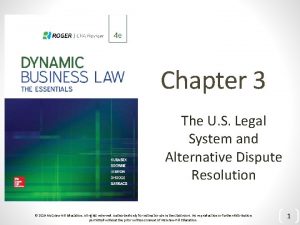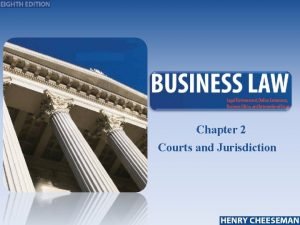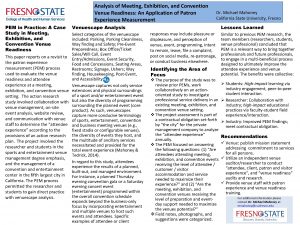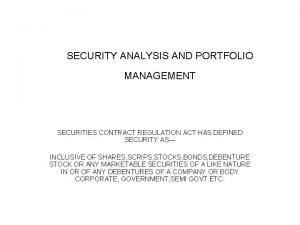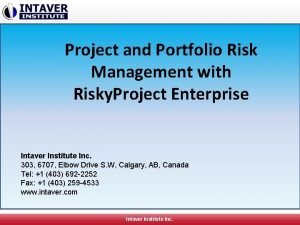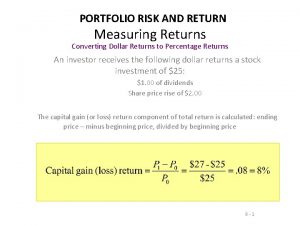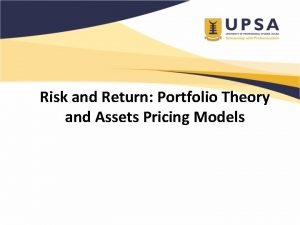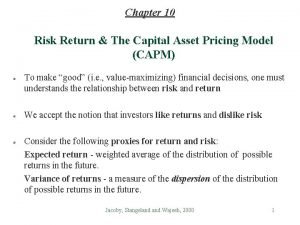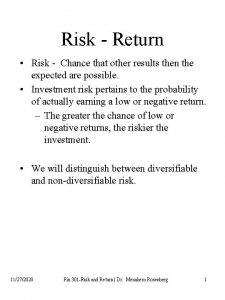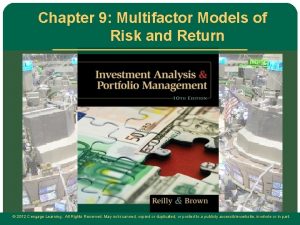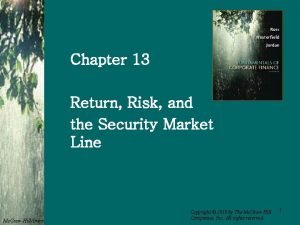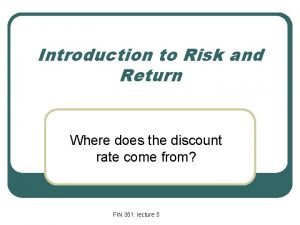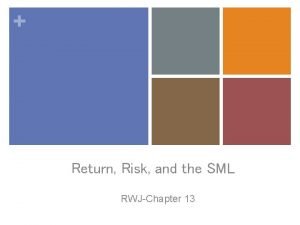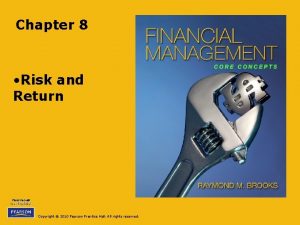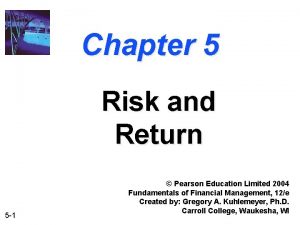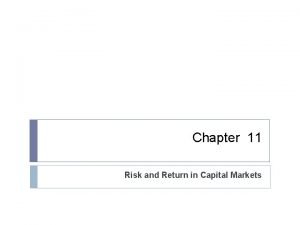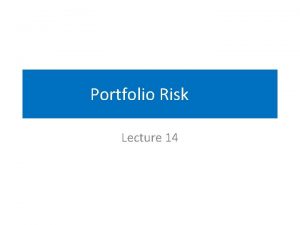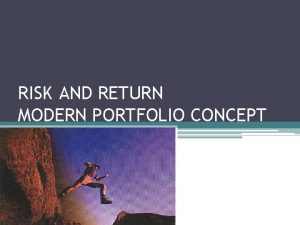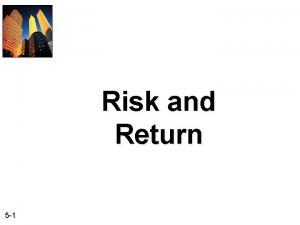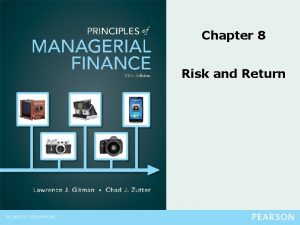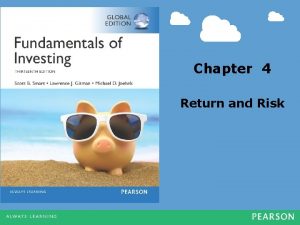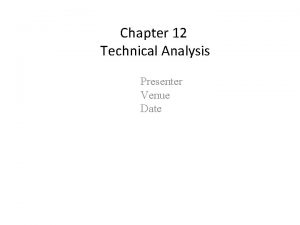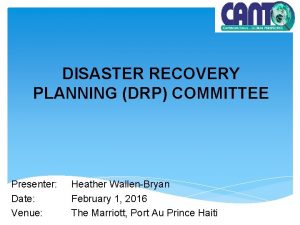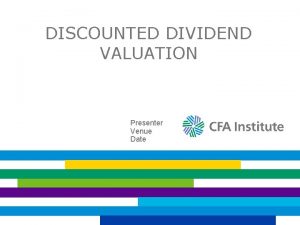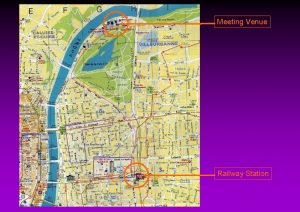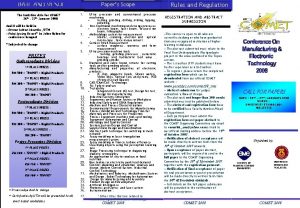PORTFOLIO RISK AND RETURN Presenter Venue Date RETURN



































- Slides: 35

PORTFOLIO RISK AND RETURN Presenter Venue Date

RETURN ON FINANCIAL ASSETS Total Return Periodic Income Capital Gain or Loss

HOLDING PERIOD RETURN A holding period return is the return from holding an asset for a single specified period of time.

HOLDING PERIOD RETURNS What is the 3 -year holding period return if the annual returns are 7%, 9%, and – 5%?

AVERAGE RETURNS Average returns Arithmetic or mean return Geometric mean return Moneyweighted return

ARITHMETIC OR MEAN RETURN The arithmetic or mean return is the simple average of all holding period returns.

GEOMETRIC MEAN RETURN The geometric mean return accounts for the compounding of returns.

MONEY-WEIGHTED RETURN

ANNUALIZED RETURN Weekly return of 0. 20%: 18 -month return of 20%:

GROSS AND NET RETURNS Gross returns Expenses Net returns

PRE-TAX AND AFTER-TAX NOMINAL RETURN Pre-tax nominal return Taxes After-tax nominal return

NOMINAL RETURNS AND REAL RETURNS

VARIANCE AND STANDARD DEVIATION OF A SINGLE ASSET Population Sample

VARIANCE OF A PORTFOLIO OF ASSETS Variance can be determined for N securities in a portfolio using the formulas below. Cov(Ri, Rj) is the covariance of returns between security i and security j and can be expressed as the product of the correlation between the two returns (ρi, j) and the standard deviations of the two assets, Cov(Ri, Rj) = ρi, j σiσj.

EXAMPLE 5 -4 RETURN AND RISK OF A TWOASSET PORTFOLIO Assume that as a U. S. investor, you decide to hold a portfolio with 80 percent invested in the S&P 500 U. S. stock index and the remaining 20 percent in the MSCI Emerging Markets index. The expected return is 9. 93 percent for the S&P 500 and 18. 20 percent for the Emerging Markets index. The risk (standard deviation) is 16. 21 percent for the S&P 500 and 33. 11 percent for the Emerging Markets index. What will be the portfolio’s expected return and risk given that the covariance between the S&P 500 and the Emerging Markets index is 0. 0050?

EXAMPLE 5 -4 RETURN AND RISK OF A TWOASSET PORTFOLIO (CONTINUED)

EXAMPLE 5 -4 RETURN AND RISK OF A TWOASSET PORTFOLIO (CONTINUED)

EXHIBIT 5 -5 RISK AND RETURN FOR U. S. ASSET CLASSES BY DECADE (%)

EXHIBIT 5 -7 NOMINAL RETURNS, REAL RETURNS, AND RISK PREMIUMS FOR ASSET CLASSES (1900– 2008)

IMPORTANT ASSUMPTIONS OF MEANVARIANCE ANALYSIS Mean-variance analysis Returns are normally distributed Markets are informationally and operationally efficient

EXHIBIT 5 -9 HISTOGRAM OF U. S. LARGE COMPANY STOCK RETURNS, 1926 -2008 Violations of the normality assumption: skewness and kurtosis.

UTILITY THEORY Expected return Utility of an investment Variance or risk Measure of risk tolerance or risk aversion

INDIFFERENCE CURVES An indifference curve plots the combination of risk -return pairs that an investor would accept to maintain a given level of utility.

PORTFOLIO EXPECTED RETURN AND RISK ASSUMING A RISK-FREE ASSET Assume a portfolio of two assets, a risk-free asset and a risky asset. Expected return and risk for that portfolio can be determined using the following formulas:

THE CAPITAL ALLOCATION LINE (CAL) E(Rp) CAL E(Ri) Rf σp σi

EXHIBIT 5 -15 PORTFOLIO SELECTION FOR TWO INVESTORS WITH VARIOUS LEVELS OF RISK AVERSION

CORRELATION AND PORTFOLIO RISK Correlation between assets in the portfolio Portfolio risk

EXHIBIT 5 -16 RELATIONSHIP BETWEEN RISK AND RETURN

EXHIBIT 5 -17 RELATIONSHIP BETWEEN RISK AND RETURN

AVENUES FOR DIVERSIFICATION Diversify with asset classes Buy insurance Evaluate assets Diversify with index funds Diversify among countries

EXHIBIT 5 -22 MINIMUM-VARIANCE FRONTIER

EXHIBIT 5 -23 CAPITAL ALLOCATION LINE AND OPTIMAL RISKY PORTFOLIO CAL(P) is the optimal capital allocation line and portfolio P is the optimal risky portfolio.

THE TWO-FUND SEPARATION THEOREM Investment Decision Optimal Investor Portfolio Financing Decision

EXHIBIT 5 -25 OPTIMAL INVESTOR PORTFOLIO Given the investor’s indifference curve, portfolio C on CAL(P) is the optimal portfolio.

SUMMARY • Different approaches for determining return • Risk measures for individual assets and portfolios • Market evidence on the risk-return tradeoff • Correlation and portfolio risk • The risk-free asset and the optimal risky portfolio • Utility theory and the optimal investor portfolio
 Awareness session invitation
Awareness session invitation Market risk assessment
Market risk assessment Record date ex dividend date
Record date ex dividend date Dividend eligibility
Dividend eligibility Weekly diary for work immersion
Weekly diary for work immersion Jurisdiction vs venue
Jurisdiction vs venue Jurisdiction vs venue
Jurisdiction vs venue Mais l'heure vient et elle est deja venue
Mais l'heure vient et elle est deja venue Pentingnya tata letak bagi perusahaan jasa
Pentingnya tata letak bagi perusahaan jasa Venue readiness
Venue readiness Next level content
Next level content Swot analysis event planning
Swot analysis event planning National gallery venue hire
National gallery venue hire Organization building venue
Organization building venue Staffing plan
Staffing plan Parys conference venues
Parys conference venues Weebly teaching portfolio
Weebly teaching portfolio Risk in security analysis and portfolio management
Risk in security analysis and portfolio management Portfolio risk register
Portfolio risk register Portfolio return formula
Portfolio return formula Bpqxxx
Bpqxxx Capital market line
Capital market line Discount rate capm
Discount rate capm Risk and return
Risk and return Market risk examples
Market risk examples Risk and return
Risk and return Multifactor model of risk and return
Multifactor model of risk and return Financial management chapter 8 risk and return
Financial management chapter 8 risk and return Chapter 13 return risk and the security market line
Chapter 13 return risk and the security market line Introduction to risk and return
Introduction to risk and return Risk and return
Risk and return Chapter 8 risk and rates of return problem solutions
Chapter 8 risk and rates of return problem solutions Contoh risk and return
Contoh risk and return Difference between risk and return
Difference between risk and return Chapter 5 risk and return
Chapter 5 risk and return Difference between risk and return
Difference between risk and return





